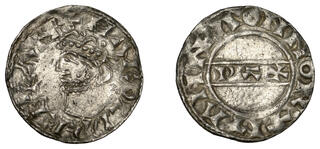| Noonans (formerly Dix Noonan Webb) > Auction 283 | Auction date: 14 November 2023 |
| Lot number: 150 Price realized: Unsold | Show similar lots on CoinArchives Find similar lots in upcoming auctions on |
| Lot description: English Hammered Coins from Various Properties Harold II (1066), Penny, PAX type, Norwich, Man, harold r rex an, bust left without sceptre, rev. manna on nor, 1.16g/3h (Pagan –; BMC –; N 837; S 1187). Struck from an obverse die of local workmanship, a few light surface marks and a trace of double-striking, otherwise very fine and extremely rare, carrying a bust of charming provincial style £4,000-£5,000 --- Provenance: found near Attleborough (Norfolk) in September 2023 (EMC 2023.0366) Harold Godwinesson's reign was famously short and bloody. It was also, from a numismatic perspective, one of administrative success. During his short reign, Harold successfully enacted a mass recoinage: during the course of 1066 most of the currency in circulation was withdrawn and re-struck at numerous provincial mints across the country. Many of the dies used in this recoinage, particularly those in the south of England, were cut at a single centre, probably located within London (as is recorded in the Domesday Book). These 'London'-made obverse dies adhere to four distinct groupings, all being of good style and - to a large extent - internally homogenous. The consistency with which these 'London' dies were employed reveals an effective system of control over the country's minting infrastructure. Of course, none of this was particularly novel, and in this regard Harold's reign demonstrated considerable continuity with what had gone before (and indeed, with what was to follow with the Normans). Nonetheless, Harold's recoinage offers an alternative perspective by which we can consider his reign, one which contrasts with the chaos and violence revealed by other contemporary sources. The coin offered for sale here was not struck from a 'London'-made obverse die. Instead, the king's portrait has a distinct and fluid style which is characteristically provincial. Evidently, the responsible moneyer, Man, found need to employ a die of local manufacture, and this should occasion some surprise. It is quite clear from the surviving coinage that the supply of dies was tightly controlled. It is equally clear, from other sources, that moneyers caught acting in an illicit manner faced severe punishment; those caught striking forgeries were dismembered, while those found to be minting outside of their burgh faced the death penalty. It seems unlikely, therefore, that Man employed this local, 'unofficial' die on a whim, and we might imagine that he was driven to this position by necessity. It is instructive here to briefly consider the case of the Wilton mint. Ordinarily, Wilton was a minor mint, producing only a modest output of coin. In the reign of Harold this arrangement changed dramatically, and Wilton became - almost instantaneously - one of the most productive mint-places in the country. Significantly, several of the dies used at Wilton during this period are irregular in style, and were not cut at the official centre in London. In his recent review of the Chew Valley Hoard, Gareth Williams notes that these irregular coins appear only in those hoards buried after the Norman conquest (and not those deposited during the course of 1066), leading to the suggestion that they 'represent a posthumous issue in the name of Harold'. Returning to Norwich, we will never know for sure why Man chose to employ an obverse die of local manufacture. We can, however, tentatively suggest that that this coin was struck at a time when the ordinary mechanisms of mint-control were failing, and that the aftermath of Harold's death at Hastings in October is one plausible context. |  |


